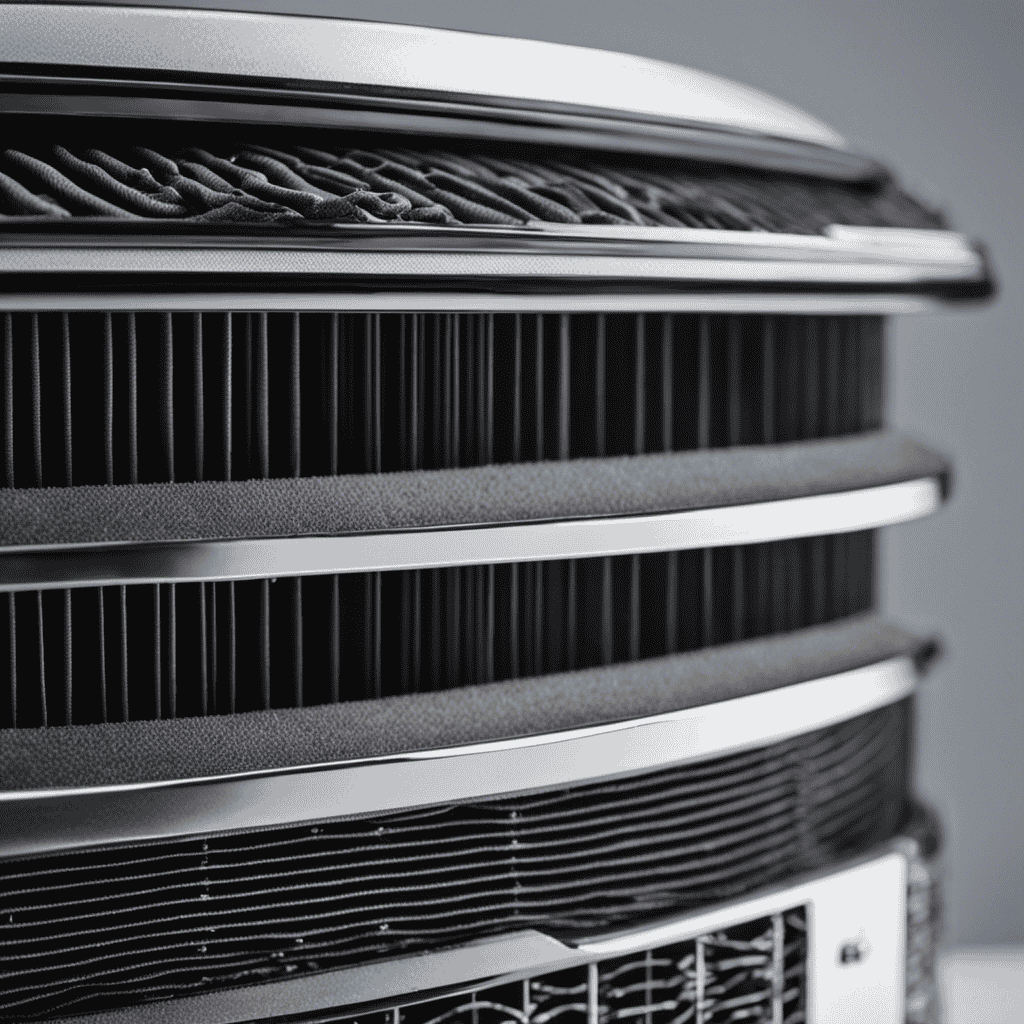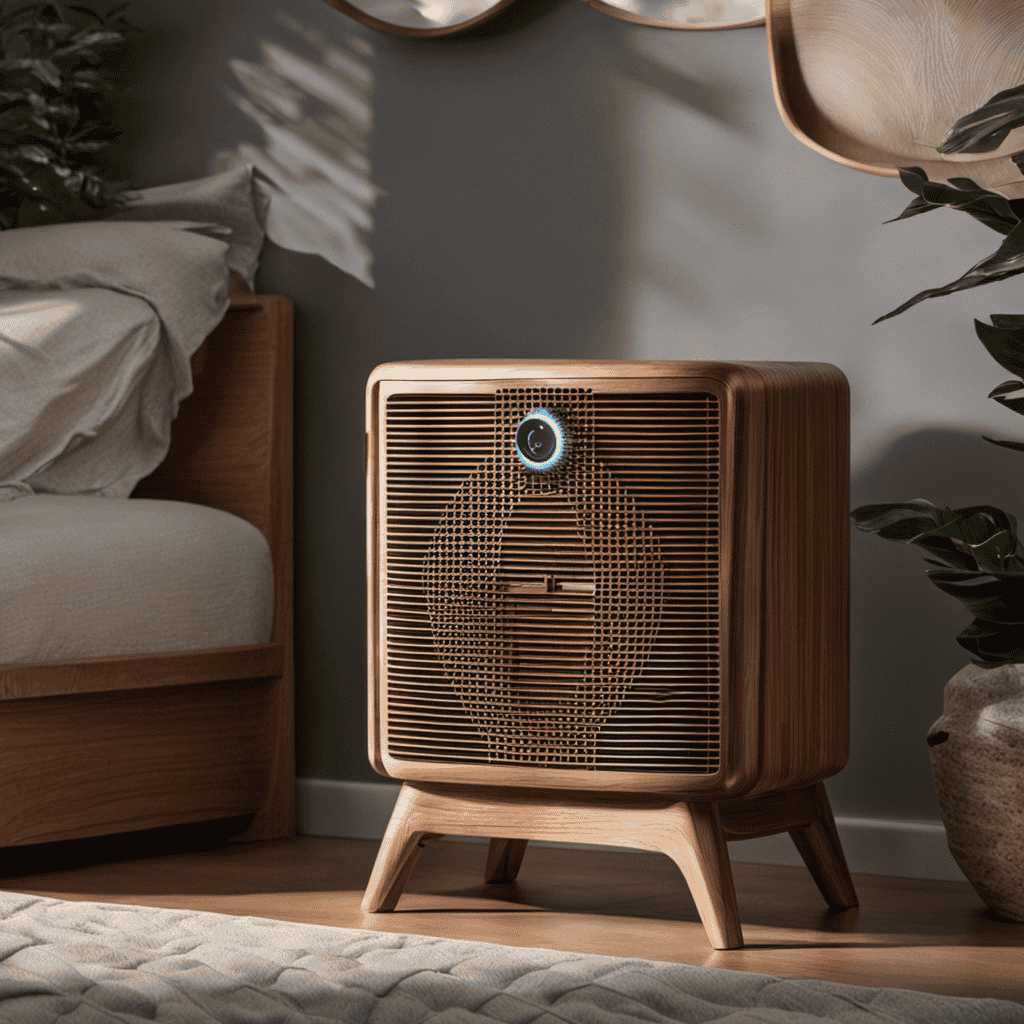So, you’re looking to purchase an air purifier, huh? Let me inform you that not all air purifiers are the same. Some may actually release ozone, a gas that can impact our health in both good and bad ways.
In this article, we’ll dive into the world of air purifiers and explore the types that actually emit ozone. We’ll also discuss the controversy surrounding these ozone-emitting purifiers and the potential health risks they pose.
So, buckle up and get ready to make an informed decision about the air you breathe.
Key Takeaways
- Some air purifiers emit ozone.
- Ozone-generating air purifiers are designed to remove odors and kill bacteria.
- Prolonged exposure to ozone can irritate the respiratory system.
- Consider alternatives like HEPA filters or activated carbon filters.
Different Types of Air Purifiers
If you’re looking for different types of air purifiers, you should know that some models emit ozone. Ozone-generating air purifiers are designed to remove odors and kill bacteria. They work by releasing ozone, a highly reactive gas, into the air.
While ozone can be effective in neutralizing odors and killing germs, it can also be harmful to human health. Research has shown that prolonged exposure to ozone can irritate the respiratory system, trigger asthma attacks, and even cause lung damage. Therefore, it is important to carefully consider the potential risks before purchasing an ozone-generating air purifier.
Instead, I recommend considering other types of air purifiers, such as HEPA filters or activated carbon filters, which do not emit ozone and still provide effective air cleaning benefits.
Understanding Ozone and Its Effects
As I delve into the discussion on ozone’s impact on health and regulations on ozone emission, it is important to approach this topic with a thorough and analytical perspective.
Ozone, a molecule composed of three oxygen atoms, can have both positive and negative effects on our health. While it plays a vital role in protecting us from harmful UV rays in the upper atmosphere, at ground level, it can contribute to respiratory issues and other health problems.
Due to these potential health risks, governments and regulatory bodies have implemented strict regulations to control and limit ozone emissions from various sources. These regulations aim to safeguard public health and the environment by promoting cleaner air and reducing ozone-related health concerns.
Ozone’s Impact on Health
You should be aware that ozone can have negative effects on your health. Ozone, a gas made up of three oxygen molecules, can be found both in the environment and indoors. Exposure to ozone can cause a variety of health issues, especially when it is present in high concentrations. Here are some important points to consider:
-
Ozone’s impact on the environment: Ozone plays a vital role in the Earth’s atmosphere, protecting us from harmful ultraviolet (UV) radiation. However, when ozone is found at ground level, it becomes a pollutant and can harm plants, crops, and ecosystems.
-
Short-term effects of ozone exposure: Breathing in ozone can lead to respiratory problems such as coughing, wheezing, and throat irritation. It can also trigger asthma attacks and worsen existing respiratory conditions.
-
Long-term effects of ozone exposure: Prolonged exposure to high levels of ozone can have serious consequences for our health. Studies have linked long-term ozone exposure to reduced lung function, increased risk of respiratory infections, and even premature death.
It is crucial to be aware of the potential health risks associated with ozone exposure and take necessary precautions to protect ourselves and our environment.
Regulations on Ozone Emission
The regulations on ozone emission have been put in place to limit the amount of this harmful gas released into the atmosphere. Ozone, when present in high levels in the air we breathe, can have detrimental effects on our health.
It can cause respiratory issues, such as coughing, shortness of breath, and chest pain. Long-term exposure to high levels of ozone can even lead to chronic respiratory diseases, such as asthma and bronchitis.
To protect public health and the environment, governments around the world have implemented regulations to control and reduce ozone emissions. These regulations set limits on the amount of ozone that industries, vehicles, and other sources can release into the air.
Air Purifiers With Ozone-Generating Technology
When it comes to air purifiers with ozone-generating technology, it is important to thoroughly examine the effectiveness of ozone in purifying the air.
While ozone has been touted as a powerful air purifier, there are potential health risks associated with its use.
Therefore, it is crucial to explore alternative options that can effectively clean the air without the potential drawbacks of ozone generators.
Ozone’s Air Purification Effectiveness
If you’re considering an air purifier, it’s important to understand the effectiveness of ozone in purifying the air. Ozone, a molecule composed of three oxygen atoms, has been used in air purification due to its ability to eliminate odors and kill bacteria and viruses. However, its effectiveness as an air purifier is debatable.
Ozone can effectively remove certain airborne pollutants, such as smoke and volatile organic compounds (VOCs). It can neutralize strong odors caused by pets, cooking, and chemicals. Ozone has the potential to kill bacteria and viruses in the air.
However, it’s important to note that ozone’s impact on health is a major concern. High levels of ozone can irritate the respiratory system and worsen asthma symptoms. It can also cause chest pain, shortness of breath, and throat irritation. Therefore, it is crucial to carefully consider the potential health risks associated with ozone-generating air purifiers.
Potential Health Risks
To protect your health, it’s important to be aware of the potential risks associated with using an ozone-generating air purifier.
Ozone exposure has been linked to various health problems, especially when inhaled in high concentrations over a long period of time. Long-term exposure to ozone can lead to respiratory issues such as coughing, wheezing, and shortness of breath. It can also aggravate existing conditions like asthma and bronchitis.
Studies have shown that prolonged exposure to ozone can cause lung inflammation and damage the lining of the respiratory system. Additionally, ozone exposure has been associated with an increased risk of cardiovascular issues and decreased lung function.
Therefore, it is crucial to carefully consider the potential health risks before using an ozone-generating air purifier.
Alternatives to Ozone Generators
Consider using alternative methods of air purification that do not emit ozone, as these options can still effectively improve the air quality in your home without posing potential health risks.
There are a few alternatives to ozone generators that are worth considering:
-
Air ionizers: These devices work by releasing negatively charged ions into the air, which attach to airborne particles and cause them to fall to the ground or stick to surfaces. Air ionizers can be effective in reducing allergens, dust, and other pollutants in the air.
-
HEPA filters: High-efficiency particulate air (HEPA) filters are known for their ability to trap microscopic particles, including pollen, pet dander, and dust mites. They can effectively remove these pollutants from the air, improving indoor air quality.
-
Activated carbon filters: These filters are effective in removing odors, gases, and chemical pollutants from the air. They work by absorbing these substances onto their porous surface.
The Controversy Surrounding Ozone-Emitting Air Purifiers
Be aware that there is a heated debate surrounding ozone-emitting air purifiers and their potential risks to your health.
Scientific research has shown that ozone, when present in high concentrations, can be harmful to human health. Ozone is a reactive gas that can irritate the respiratory system, leading to coughing, shortness of breath, and chest pain. Prolonged exposure to high levels of ozone can also cause lung damage and worsen existing respiratory conditions such as asthma.
While some argue that ozone-emitting air purifiers can effectively remove pollutants from the air, others caution against their use due to the potential health risks.
It is important to thoroughly research and consider both sides of the debate before deciding to use an ozone-emitting air purifier in your home.
Potential Health Risks of Ozone-Producing Air Purifiers
You should be cautious of the potential health risks associated with using ozone-producing air purifiers. While these devices claim to improve indoor air quality, they emit ozone, a highly reactive gas that can be harmful to your health. Here are some important points to consider:
-
Ozone exposure levels: Ozone-producing air purifiers can significantly increase ozone levels in your home. Even at low concentrations, ozone can irritate the respiratory system and cause chest pain, coughing, and shortness of breath.
-
Long-term health effects: Prolonged exposure to elevated ozone levels can have serious health consequences. Studies have linked ozone exposure to respiratory conditions such as asthma and chronic obstructive pulmonary disease (COPD). It can also exacerbate existing respiratory conditions, leading to more frequent and severe symptoms.
-
Environmental impact: Ozone emitted by air purifiers can also contribute to outdoor air pollution. When released into the atmosphere, ozone reacts with other pollutants and can form harmful smog, which is detrimental to both human health and the environment.
Considering the potential health risks and the availability of ozone-free alternatives, it is important to make informed choices when selecting air purifiers to ensure the well-being of yourself and your loved ones.
Alternatives to Ozone-Emitting Air Purifiers
To avoid potential health risks, it’s important to explore alternative options for indoor air purification.
One such option is using ozone free air purifiers, which are designed to filter out pollutants without emitting harmful ozone gas. These air purifiers use advanced technologies like HEPA filters, activated carbon filters, and UV-C light to effectively remove airborne particles, allergens, and odors from the air.
HEPA filters can trap up to 99.97% of particles as small as 0.3 microns, ensuring cleaner and healthier air for your home.
Additionally, natural air purification methods can also be considered. These methods involve using plants, such as the snake plant, peace lily, and spider plant, which can naturally filter the air by absorbing toxins and releasing oxygen.
Incorporating these alternative options into your indoor air purification routine can help maintain a healthier living environment.
Making an Informed Decision: Choosing the Right Air Purifier for You
Consider researching different brands and models of air purifiers that meet your specific needs and preferences. When choosing the right air purifier, it’s important to understand ozone emission and its potential effects on your health.
Here are three key factors to consider:
-
Ozone emission levels: Look for air purifiers that have low or no ozone emission. High levels of ozone can be harmful, especially for individuals with respiratory conditions like asthma or allergies.
-
Filtration efficiency: Check the air purifier’s filtration system and its ability to remove pollutants like dust, pollen, pet dander, and mold spores. HEPA filters are highly effective in capturing these particles.
-
Room size and coverage: Determine the size of the room where you plan to use the air purifier and ensure that the model you choose is capable of effectively purifying the air in that space.
Conclusion
In conclusion, after thoroughly analyzing the different types of air purifiers and understanding the effects of ozone, it is evident that air purifiers emitting ozone pose potential health risks.
The controversy surrounding these ozone-emitting air purifiers cannot be ignored, and it is crucial to consider alternative options.
By making an informed decision and choosing an air purifier that does not produce ozone, we can ensure the safety and well-being of ourselves and our loved ones.
Remember, health should always be the top priority, and taking precautions is paramount.










